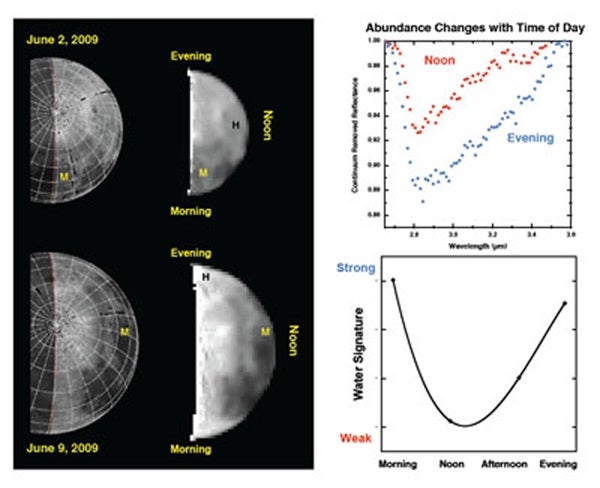New data from the Deep Impact spacecraft and the Moon Mineralogy Mapper (M3), an instrument aboard India’s recently ended Chandrayaan-1 spacecraft, provide, for the first time, clear evidence that water exists on the surface of the Moon.
“The Deep Impact observations of the Moon not only unequivocally confirm the presence of OH/H2O on the lunar surface, but also reveal that the entire lunar surface is hydrated during at least some portions of the lunar day,” said University of Maryland astronomer Jessica Sunshine.
“Finding water on the Moon in daylight is a huge surprise, even if it is only a small amount of water and only in the form of molecules stuck to soil,” said Sunshine. Prevailing scientific opinion long has been that there probably is no water on the Moon and that, even if it does exist, it would be only in permanently cold, shadowed craters at the lunar poles. “In the Deep Impact data, we’re essentially watching water molecules form and then dissipate right in front of our eyes,” said Sunshine, whose first reaction to the M3 data was skepticism.
“We aren’t certain yet how this happens,” Sunshine said, “but our findings suggest a solar driven cycle in which layers of water only a few molecules thick form, dissipate, and reform on the surface each lunar day. We postulate that hydrogen ions from the Sun are carried by the solar wind to the Moon and there interact with oxygen rich minerals in lunar soil to produce the water [H20] and hydroxyl [OH] molecules that spectral analysis unequivocally show us is there. In a cycle that occurs entirely in daylight, this water is formed in the morning, substantially lost by lunar mid-day, and re-formed as the lunar surface cools towards evening.
“If this is correct, then such hydration via solar wind would be expected to occur throughout the inner solar system on all airless bodies with oxygen-bearing minerals on their surfaces,” Sunshine said.
“Within the context of lunar science, this is a major discovery,” said Paul G. Lucey, a planetary scientist with the University of Hawaii. “There was zero accepted evidence that there was any water at the lunar surface, [but] now it is shown to be easily detectable, though by extremely sensitive methods. As a lunar scientist, when I read about this I was completely blown away,” said Lucey, who was not involved in the current research.
“Water ice on the Moon has been something of a holy grail for lunar scientists for a very long time,” said Jim Green, director of the Planetary Science Division at NASA headquarters in Washington.
“Without the spectral range of Deep Impact’s instruments, the M3 discovery of surface water would not have been nearly so definitive, and because the Deep Impact spacecraft took observations at different times of the lunar day, the effect of temperature became very apparent,” Sunshine said.










